Registering Device Presets
The connection information for an external device used for capturing or exporting (camera, deck, web camera, microphone, video input/output hardware, etc.) is registered and managed as a preset in the device presets. Capturing or exporting operation can be performed smoothly by loading the registered device preset.
Before registering device presets, connect the external device (e.g. camera) used for input/output to your PC, and turn it on.
Connecting to External Devices

-
It is not necessary to register external devices in which file-based video or audio are recorded (e.g. AVCHD video camera, professional-use video camera, removable media such as SD memory card, XDCAM EX device) as device presets.
1) Click [Settings] on the menu bar, and click [System Settings].
|
|
|---|
|
2) Click the [Hardware] tree, and click [Device Preset].
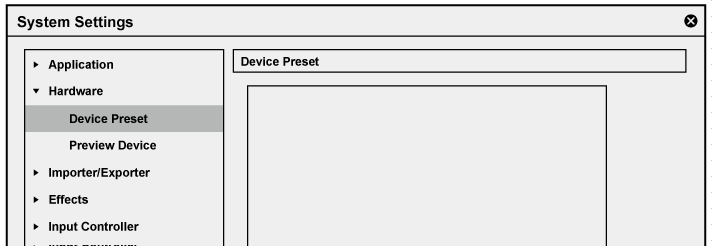
-
The [Device Preset] screen appears.
3) Click [New].

-
[Preset Wizard] will start up.
 Alternative
Alternative
-
Right-click a blank area in the device preset list, and click [New].
4) Enter the name of the device preset.
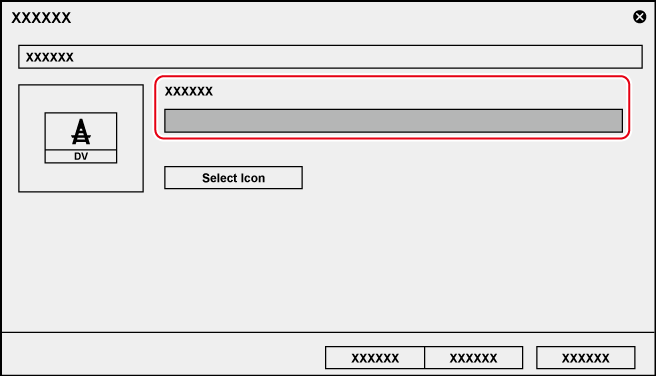
5) Click [Select Icon], select the icon image, and click [OK].
-
To use any image you like, click [...] and select a file.
6) Click [Next].
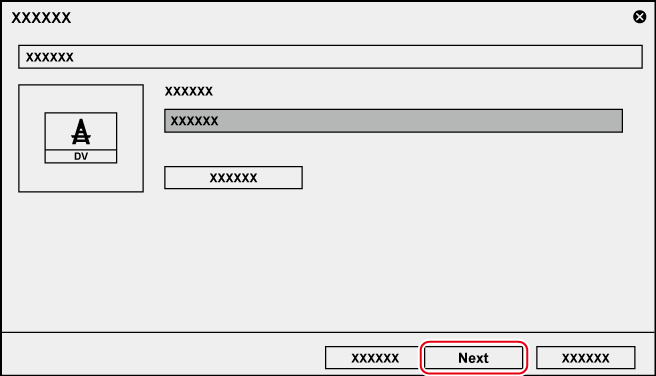
-
The [Input H/W, Format Settings] screen appears.
7) Set each item and click [Next].
8) Confirm the details, and click [Completed].
-
The icon of the newly created preset is displayed in the device preset list.
[Device Preset] Screen
|
Device preset list |
Displays a list of device presets. The list can be resorted by dragging the icons. The list is not displayed when there are no device presets registered. |
|
[New] |
Create new device presets. |
|
[Modify] |
Change the settings of the selected device preset. |
|
[Delete] |
Delete the selected device preset. |
[Input H/W, Format Settings] Screen
This section explains settings when video is input from a DirectShow capture device.
For more information on settings when using Grass Valley products for input, see the user manual included with the product.
|
[Interface] |
Click this item to select the interface to use for input. To input from a DirectShow base video capture device or audio capture device, select [DirectShow Capture]. When the interface to use for input is selected from the list, the content of each of the items such as [Stream] switches to match the selected interface. To disable use of an interface for input, select [Not Select]. |
|
|
[Stream] |
When [DirectShow Capture] is selected at [Interface], select your device. The displayed device name varies depending on your product. You can make device settings by clicking [Settings]. When your device is a video capture device, you must set the associated audio capture device. |
|
|
[Video Format] |
Select the video format for the source to capture. |
|
|
[Codec] |
Select the codec to use for capture depending on the video format. You can make codec settings by clicking [Settings]. [Settings - Grass Valley HQ]/[Settings - Grass Valley HQX] Dialog Box [Settings - MPEG2 Custom] Dialog Box [Settings - XDCAM HD422 Compatible] Dialog Box [Settings - XDCAM EX Compatible] / [Settings - XDCAM HD Compatible] Dialog Box |
|
|
[File Format] |
Select the file format of the captured clip depending on the video format. |
|
|
[Proxy File] |
Select a file (only high-resolution/high-resolution and proxy) to be created when capturing. |
|
|
[Audio Format] |
Select the audio format of the source to capture depending on the video format. |
|
|
[Audio Input] |
Select the audio input interface depending on the video format. |
|
|
[Convert 16Bit/2ch] |
Select whether to import audio by 16 -bit/2ch depending on the video formats. |
|
* Selectable items differ according to the setting.
[Settings - Device Setting] Dialog Box (DirectShow Capture)
|
[Video Device] |
Displays the video capture devices connected to the system. Click [Video Setting] to display detailed settings depending on your video capture device. For more information on settings, see the manual for your device. |
|
[Audio Device] |
Displays the audio capture device connected to the system. Select the audio capture device corresponding to the video capture device from the list. To cancel this setting, select [Not assigned]. |
|
[Set video frame rate from audio sampling rate.] |
Check this item to calculate the frame rate from the number of samples and duration time of the audio. Uncheck this item to calculate the frame rate from the frame rate provided by the video capture device, and convert the audio sampling rate to match the frame rate. |
[Settings - Grass Valley HQ]/[Settings - Grass Valley HQX] Dialog Box
|
Codec settings |
[Online(SuperFine)] This item can be selected for a Grass Valley HQX codec. This setting provides the highest image quality, though the file size increases. Select this when importing at high image quality is needed. This item cannot be selected for a Grass Valley HQ codec. [Online(Fine)] This setting provides high image quality, though the file size increases. Select this when importing at high image quality is needed. [Online(Standard)] Normally, you can get sufficient image quality at this setting. [Offline] Select this item to encode at a lower bitrate. [Custom] [Q] and [Max size] can be adjusted. [Q] adjusts image quality. Set within the range 4 to 19 (0 to 18 in the case of a Grass Valley HQX).Setting a smaller value results in higher image quality. [Max size] sets the maximum bitrate. You can set to limit the file size that increases inadvertently as a result of excessive noise in the video. Setting value “100” % means the same bitrate before codec compression. For example, 100% for 1440x1080 59.94i is a bitrate of approximately 750 Mbps. To set the upper limit to 200 Mbps, set “27” % as the maximum size. |
|
|
|---|
|
[Settings - MPEG2 Custom] Dialog Box
|
[Bit Rate] |
Select a bitrate type. [CBR] sets a fixed transfer rate, allocating a fixed number of bits during the encoding process. Select a bitrate from the [Average] list. You can also enter a value directly. [VBR] sets a variable transfer rate, altering the number of assigned bits according to the complexity of the movement or image quality. Compared with [CBR], the media volume can be used more efficiently, and this enables more consistent image quality overall. Select a bitrate from the [Average] and [Max] lists. You can also enter a value directly. |
|
[Quality/Speed] |
Select quality from the list. |
|
[GOP Structure] |
For MPEG, a certain number of frames is considered as a group, and operations such as compression/enlargement and cut editing are performed on a GOP basis. A GOP comprises “I frame”, “P frame” and “B frame”. The I frame allows images to be reproduced independently, the P frame is for recording and reproducing only the differences with the preceding image, and the B frame reproduces images from the differences in the preceding and following images. Select I, P and B frame patterns of the GOP from the list. Normally, select [IBBP]. [I-Frame Only] is comprised of only I-pictures. Editing is made easier, but the amount of data increases in size. |
|
[Picture count] |
Set the number of frames included in a group. |
|
[Closed GOP] |
Check this item to complete information within each GOP. Although the amount of data increases, the video can be re-edited using software that supports GOP-based editing. Normally, leave this item unchecked. |
|
[Chroma Format] |
Select a YUV pixel format from the list. |
|
[Profile/Level] |
Select a profile & level. If [Chroma Format] is [4:2:0] and [4:2:2], the profile will be set to Main Profile and 422Profile, respectively. The level for SD image quality will be Main Level, and the level for HD image quality will be High Level. The profile & level changes according to the format selected in [Chroma Format]. |
|
[VBV Buffer Size] |
Select the setting method for the VBV buffer upper limit value. When [Default] is selected, the VBV buffer upper limit value is set using current settings. |
[Settings - XDCAM HD422 Compatible] Dialog Box
|
[Quality/Speed] |
Select quality from the list. |
|
[Closed GOP] |
Check this item to complete information within each GOP. Although the amount of data increases, the video can be re-edited using software that supports GOP-based editing. Normally, leave this item unchecked. |
[Settings - XDCAM EX Compatible] / [Settings - XDCAM HD Compatible] Dialog Box
|
[Bit Rate] |
Select a bitrate from the list. |
|
[Quality/Speed] |
Select quality from the list. |
|
[Closed GOP] |
Check this item to complete information within each GOP. Although the amount of data increases, the video can be re-edited using software that supports GOP-based editing. Normally, leave this item unchecked. |
[Settings - MPEG IMX] Dialog Box
|
[Bit Rate] |
Select a bitrate from the list. |
Detailed Setting of Device Preset
[Video Input Settings] (STORM 3G)
This is the setting for the input signal adjustment used for capturing.
The setting is available only for the component, S-video, or composite input.
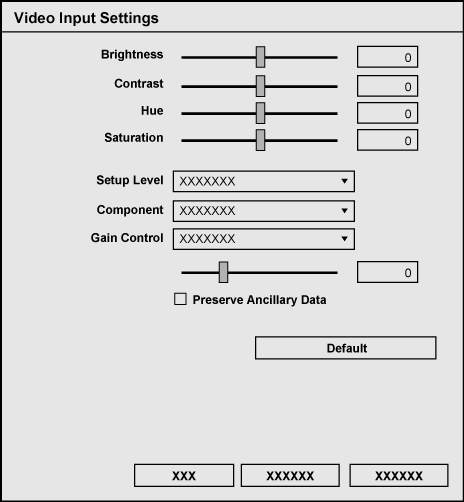
|
[Brightness] |
Adjusts the brightness of video. It will become darker when the value is smaller, and brighter when the value is larger. |
|
[Contrast] |
Adjusts the contrast of image. The contrast will be weaker when the value is smaller, and stronger when the value is larger. |
|
[Hue] |
Adjusts the hue of video. Red will be stronger when the value is smaller, and green will be stronger when the value is larger.
|
|
[Saturation] |
Adjusts the deepness of the color. The color becomes lighter when the value is smaller, and deeper when the value is larger. The image will become grayscale when set to 0 (minimum value). |
|
[Setup Level] |
Sets the setup level (black level) for NTSC. |
|
[Component] |
Selects the component level for NTSC. |
|
[Gain Control] |
Sets the video luminance. [Manual] will set the luminance manually. [Automatic] will set the luminance to optimum automatically. |
|
[Preserve Ancillary Data] |
Check this to append ancillary data such as closed caption during capturing. |
|
[Default] |
Restores to the default setting. |
[Audio Input Settings] (STORM 3G/STORM Pro)
This is the setting for the input device used for capturing.
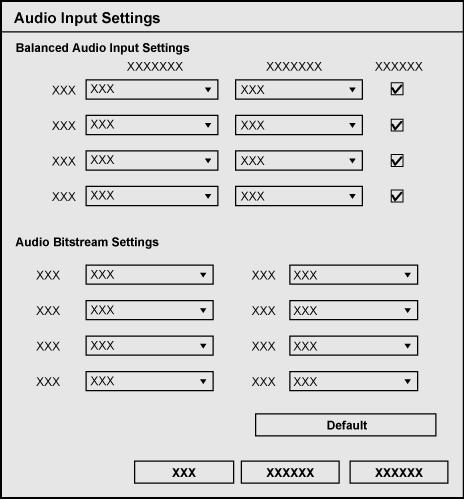
|
[Balanced Audio Input Settings] |
[Input Headroom[dB]] Sets the headroom from the reference input level from [20], [18], [16], or [12]. [Input Level[dBm]] Sets the reference input level from [+4], [0], [-3], [-6], or [-20]. [600 ohm Termination] Check this option to enable 600 Ω terminator of the balanced audio input terminal. This can be set for each channel individually. |
|
[Audio Bitstream Settings] |
Sets the handling of the digital audio signal for SDI embedded audio input. It will be saved as linear PCM data and handled as normal audio signal during editing when [LPCM] is selected. It will be saved as AC-3 audio bitstream when [AC-3] is selected. It will be saved as Dolby-E audio stream when [Dolby-E] is selected. |
|
[Default] |
Restores to the default setting. |
